Transforming a swimming pool into a captivating Koi fish pond involves a seamless blend of creativity and technique. This metamorphosis repurposes the space and breathes new life into your surroundings. This guide delves into a realm where aquatic aesthetics meet scientific precision.
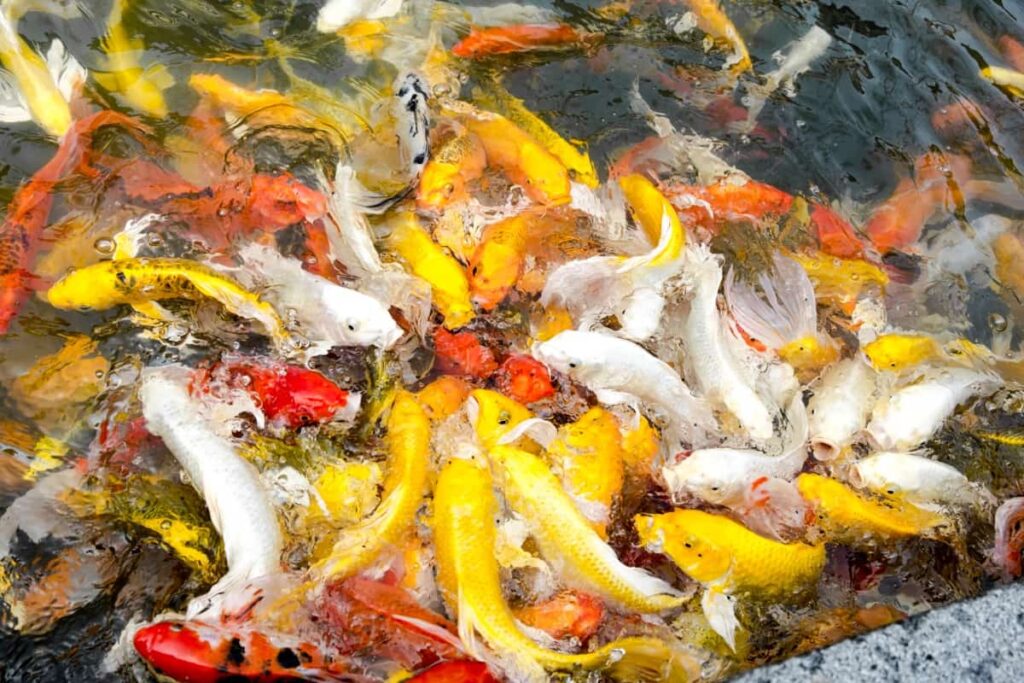
Explore innovative ideas, expert tips, and proven techniques that navigate the intricate waters of converting a chlorinated oasis into a haven for vibrant Koi. Embark on a journey that harmonizes artistic vision with meticulous execution, resulting in a mesmerizing aquatic sanctuary.
How to Convert a Swimming Pool Into Koi Fish Pond
What is the Conversion of the Swimming Pool Into Koi Fish Pond?
Converting a swimming pool into a Koi fish pond transforms the pool into a suitable habitat for Koi fish. The pool’s water is changed to make it safe for fish, and filtration systems are added. The pool’s color might be changed to fit the pond’s aesthetics. Then, Koi fish are introduced, along with plants and suitable substrate. Regular pond maintenance, including treatments for issues like algae, keeps the pond healthy. This conversion turns a pool into a vibrant aquatic space for Koi fish, creating a harmonious blend of water and life.
Understanding the Basics of Converting a Swimming Pool Into a Koi Fish Pond
- Preparation is Key: Converting a swimming pool into a Koi fish pond starts with thorough planning. Consider the pool’s size, location, and existing features.
- Water Transformation: Remove the chlorinated water from the pool. Replace it with fresh water suitable for Koi fish. This ensures their health and well-being.
- Filtration and Circulation: Install appropriate pond pumps and filters. They keep the water clean and oxygenated, vital for Koi’s survival. Choose the right ones based on your pond’s size.
- Color Palette Shift: Changing the pool’s color from bright blue to a more natural hue is a common step. This aligns the pond with the Koi’s natural habitat.
- Welcoming Plants and Substrate: Add plants to provide shade, oxygen, and a natural feel. A suitable substrate, like pebbles, aids filtration and offers a comfortable bottom for Koi.
- Koi Selection: Introduce Koi fish to their new home. Choose species compatible with your climate and pond size.
- Maintenance Matters: Regular pond maintenance is crucial. Perform water tests, clean filters, and monitor fish health. Treatments may be needed to manage algae and other issues.
Ideas, Tips, and Techniques for Swimming Pool Into Koi Fish Pond
- Enhancing Outdoor Space: Transforming an underused pool into a picturesque Koi pond adds visual appeal and value to your property.
- Conversion Considerations: Assess factors like cost, maintenance, and local regulations before committing to the conversion process.
- Key Factors for Koi Pond: Ensure successful conversion by addressing filtration, size, food, water conditions, lighting, and maintenance.
- Challenges and Rewards: Overcome challenges related to maintenance demands, water chemistry, and potential mosquito issues. Enjoy the rewards of a serene and vibrant pond.
- Professional Consultation: Seek advice from experienced professionals to optimize the transformation process and ensure your Koi pond thrives.
- Cost Estimations: While conversion costs vary, budget for potential expenses, such as installing liner waterproofing and filtration system.
- Step-by-Step Conversion: Empty and clean the pool, seal it with a liner, install a filtration system, and gradually fill it with clean water. Introduce Koi fish carefully, monitor their health, and relish the stunning outcome.
In case you missed it: Grouper Fish Farming Business Plan: Ultimate Guide to Breeding and Reproduction Techniques
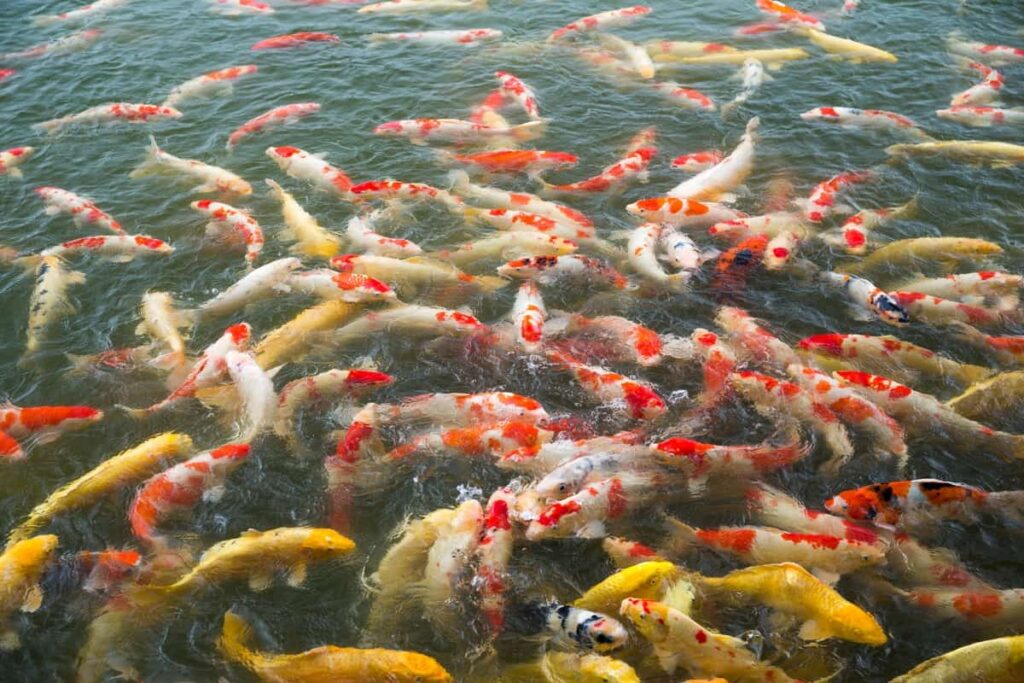
How to Change a Swimming Pool to Koi Pond for Fish Farming
- Color Metamorphosis: Begin by transforming the pool’s vibrant blue into a more serene hue that blends harmoniously with a garden pond’s surroundings.
- Progressing to Pond Equipment: Transition towards choosing the right pond pumps and filters. Tailor your choices based on the water feature’s size and the specific fish species you plan to house. Clear the way by draining the chlorinated water, allowing for new pipes and an advanced filtration system.
- Exploring Pond Pump and Filter Options: Explore our Pond Pumps and Pond Filters pages for a comprehensive understanding. Select the ideal filter foams, ensuring the water maintains pristine quality for the fish’s arrival.
- Fish and Plant Selection: Select suitable fish and pond plants once the pool canvas is pristine and the filtration system is set up. Employ a suitable substrate like Pebbles and Colored Stones for aesthetics and to aid filtration. Facilitate plant growth with Plant Fertilizers, fostering healthy root development.
- Pond Maintenance: Enter the maintenance phase. Invest in essential Pond Treatments comparable to nurturing an underwater garden. These treatments address diverse aquatic issues, including a crucial algae treatment that curbs excessive blooms, maintaining a balanced ecosystem.
Assessing the Feasibility of Your Swimming Pool Being Suitable for Conversion
The conversion process offers affordability and speed, with the installation of essential infrastructure being the first step. Some pools lack a bottom drain, but innovative solutions can be applied for optimal results once the fish inhabit the pond. Choosing a suitable filtration system is crucial for water purification, and altering the pool’s color, often to black, can enhance aesthetics. After draining the pool, installing the new filtration unit and pipework becomes necessary. The next stages include refilling the pond and introducing Koi fish alongside planters and wetlands.
Planning and Designing: Creating a Functional and Aesthetic Koi Fish Pond
Begin by assessing the available space and determining the pond’s dimensions. On average, a Koi pond should be around 1,000 to 2,000 gallons in capacity for optimal fish health and growth. Consider the pond’s depth as well; it’s recommended to have a depth of at least 3 to 4 feet to provide a stable environment for Koi during different weather conditions. Adequate filtration is essential, with a system capable of cycling the pond’s water volume every hour.
In case you missed it: From Water Quality to Feeding Habits: A Comprehensive Guide to Successful Fishpond Management
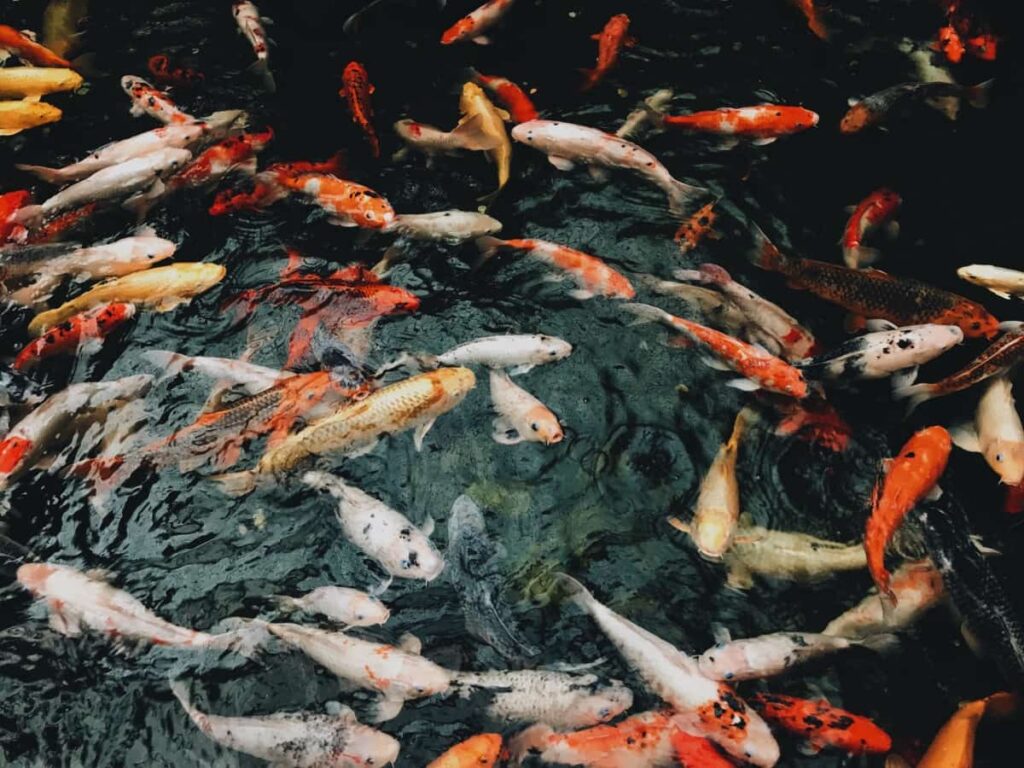
A well-designed pond includes elements such as shelves and ledges, which provide varying water depths and resting places for the fish. Plan proper aeration through water features like waterfalls or air pumps to maintain oxygen levels. In terms of aesthetics, choose a pond liner that suits the design and ensures water retention. Integrate natural elements like rocks, plants, and aquatic vegetation to create a harmonious environment. It’s recommended to have plant coverage of around 60% of the pond’s surface to provide shade and natural filtration.
Removing the Pool Equipment: Preparing the Pool for Conversion
This process involves disassembling and disconnecting existing pool components, including pumps, filters, and heaters. Proper removal is critical to ensure the pool’s transformation aligns with the needs of aquatic life. Begin by draining the pool below the equipment outlets to prevent water backflow during disassembly. Scientifically, this reduces the risk of damaging the equipment and optimizes safety. Carefully disconnect and remove pumps and filters, considering their positioning and connections.
Drainage valves should be correctly closed to prevent water leakage, utilizing gravity and hydraulic principles. Scientific precision ensures the water doesn’t compromise the removal process or cause unintended damage. Accurate disconnection and removal ensure a clean slate for the forthcoming pond equipment installation. This meticulous approach safeguards the pool’s structural integrity while laying the foundation for a successful conversion.
Adjusting Water Depth and Shape for Survival of Koi Fish
Adapting water depth and shaping are pivotal for Koi fish survival. Scientifically, a water depth of at least 3 to 4 feet provides thermal stability, shielding fish from temperature extremes. Proper depth also safeguards against predators and facilitates natural behaviors. The pond’s shape should mimic natural habitats, supporting fish movement and ensuring oxygen distribution.
A tapered design, with shallower areas around the edges and gradual slopes, aligns with fish comfort. These scientific adjustments offer escape zones vital for Koi safety. Adequate depth and shaping contribute to balanced thermoregulation, optimal oxygen exchange, and psychological well-being, enhancing the Koi’s overall survival and health within their transformed aquatic environment.
Installing Filtration and Aeration Systems in the Pond
Install filtration and aeration systems in the pond to maintain a healthy environment for Koi fish. Filtration systems work like nature’s cleaning crew, removing debris and keeping the water clear. They use various mechanisms to trap particles and harmful substances, ensuring the water stays safe.
In case you missed it: The Rise of Fish Farming in Nigeria: Key Rules to Start from Scratch
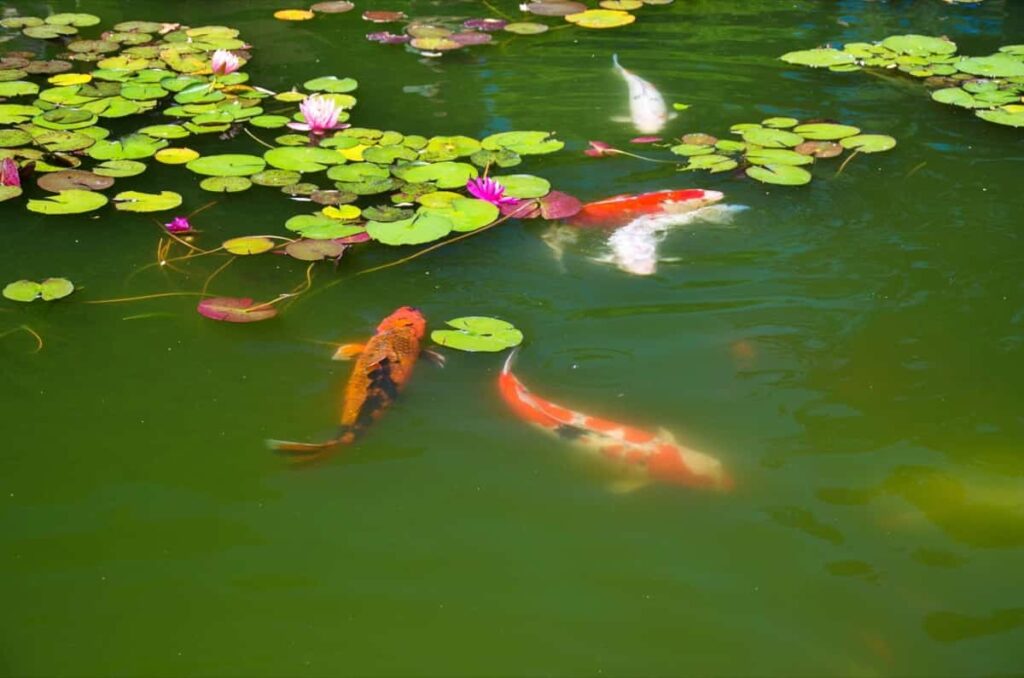
Aeration systems pump in the air, creating movement on the water’s surface. This introduces oxygen into the water, which is vital for the fish to breathe and beneficial bacteria to thrive. Proper oxygen levels also prevent stagnant water and harmful gases from building up. Both systems work together to maintain water quality and create a balanced ecosystem. The Koi fish benefit from clean and oxygen-rich water, promoting their growth and well-being.
Best Management Tips for Swimming Pool Into Koi Fish Pond
- Preparation and Cleaning: Start by cleaning and preparing the pool. This presents an ideal opportunity if it’s in-ground and no longer in use. If opting for an above-ground pool, you can find great deals online or locally. Ensure the pool is clean and chemical-free, providing a fresh foundation.
- Water Filling and Settling: Fill the pool with water and allow it to sit for 7-10 days. This timeframe allows chlorine and additives to dissipate and any sediment to settle at the bottom.
- Implement Filtration: Introduce filtration systems, crucial for maintaining a healthy aquatic ecosystem. Choose from biological, mechanical, and clarifier filters to ensure water quality. Adequate filtration is vital for the well-being of fish, especially those like trout and salmon.
- Incorporate Aquatic Plants: Add floating or submerged plants after the water settles. These include water hyacinth, iris, and more. Around half of the water’s surface should be covered with plants, providing natural filtration and promoting fish health.
- Feeding and Maintenance: Fish can feed on natural plant matter and insects like mosquitoes, contributing to their diet. For self-sustainability, consider cultivating an ecosystem where plants filter water, providing a nutritious environment for fish.
Adding Rocks, Plants, and Hiding Spots for Koi Fish
When enhancing your Koi fish pond with rocks, plants, and hiding spots, selecting elements that cater to the well-being of Koi and complement their natural habitat is essential. Opt for fish species that thrive in pond environments, such as Koi (Cyprinus carpio), known for their vibrant colors and resilience. Choose rocks that are smooth and varied in size, creating underwater caves and resting spots for the fish. Granite, limestone, and slate are suitable options.
In case you missed it: The Rise of Fish Farming in Kenya: Key Rules to Start from Scratch
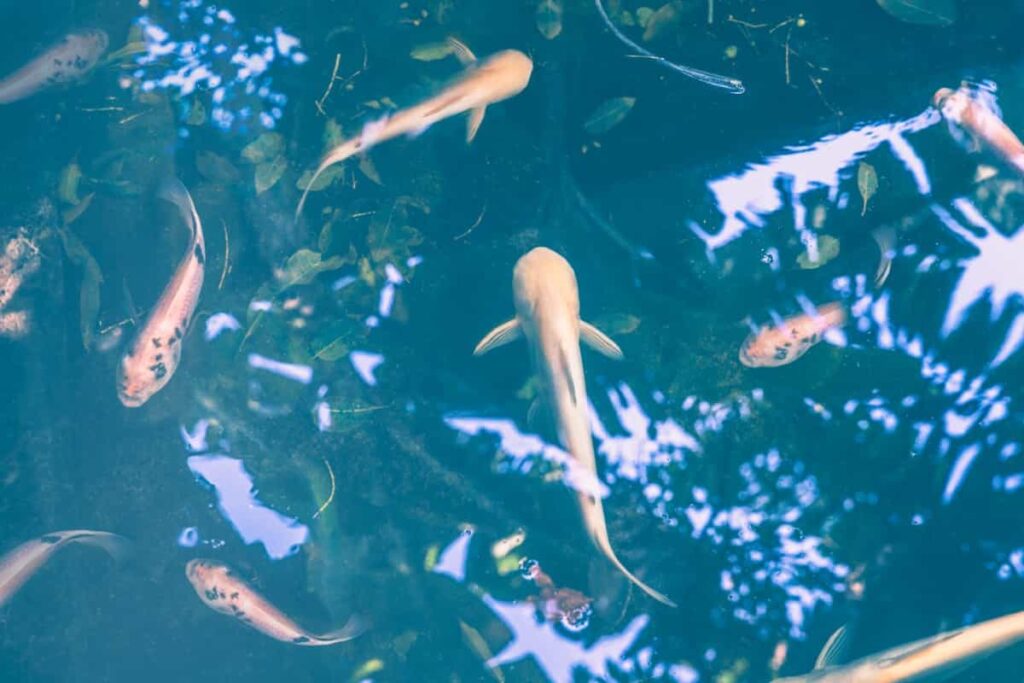
Incorporate aquatic plants like water lilies (Nymphaea) for shade and visual appeal. Submerged plants like anacharis (Elodea) oxygenate the water and serve as hiding places. Provide hiding spots with aquatic structures or submerged pipes, allowing Koi to retreat from predators. Select species of plants like water lettuce (Pistia) and water hyacinth (Eichhornia crassipes) that float on the water’s surface, adding protection and aesthetic charm.
Introducing Koi Fish to the Pond
Introducing Koi fish to your pond is a pivotal step. Allow the pond water temperature to match where the Koi currently reside. Float the fish in a bag on the pond’s surface, allowing them to acclimate to the water’s temperature. Gradually add pond water to the bag over an hour to help them adjust. Gently release the Koi into the pond, ensuring they swim independently. Avoid sudden changes to water conditions, which can stress the fish. Adequate acclimatization ensures a smooth transition and promotes the Koi’s well-being in their new aquatic home.
Monitoring and Adjusting Water Ph, Temperature, and Oxygen Levels
- pH Levels: Aim for a pH range of 7.0 to 8.5, providing a balanced environment for Koi.
- Water Temperature: Keep water between 65°F – 75°F (18°C and 24°C) for Koi health and activity.
- Oxygen Levels: Ensure dissolved oxygen levels stay above seven mg/L, facilitating fish respiration.
- Regularly test the water using kits and adjust as needed. Aerate the water to boost oxygen, and use shade to regulate temperature.
Addressing Challenges in Your Koi Fish Pond Conversion
- Water Quality Transition: The pool’s chemical-rich water needs thorough removal and replacement with fresh, fish-friendly water.
- Filtration Adaptation: Pools lack proper filtration for fish. Installing appropriate systems is vital for water clarity and Koi health.
- Aesthetic Adjustment: Transforming the pool’s appearance to mimic a natural pond aesthetic can be complex, involving color changes and landscape integration.
- Temperature Regulation: Maintaining suitable water temperatures for Koi year-round is challenging. Proper insulation and heating mechanisms are essential.
- Ecosystem Establishment: Establishing a balanced ecosystem with aquatic plants and bacteria takes time and attention to detail.
- Fish Introduction and Acclimation: Introducing Koi requires acclimation to new water conditions, temperature, and pH levels.
- Maintenance Transition: Ponds need different care compared to pools. Mastering pond-specific maintenance routines is crucial for long-term success.
In case you missed it: Project Report of Pangasius Fish Farming: Cultivation Economics, Production Cost, and Profit Analysis
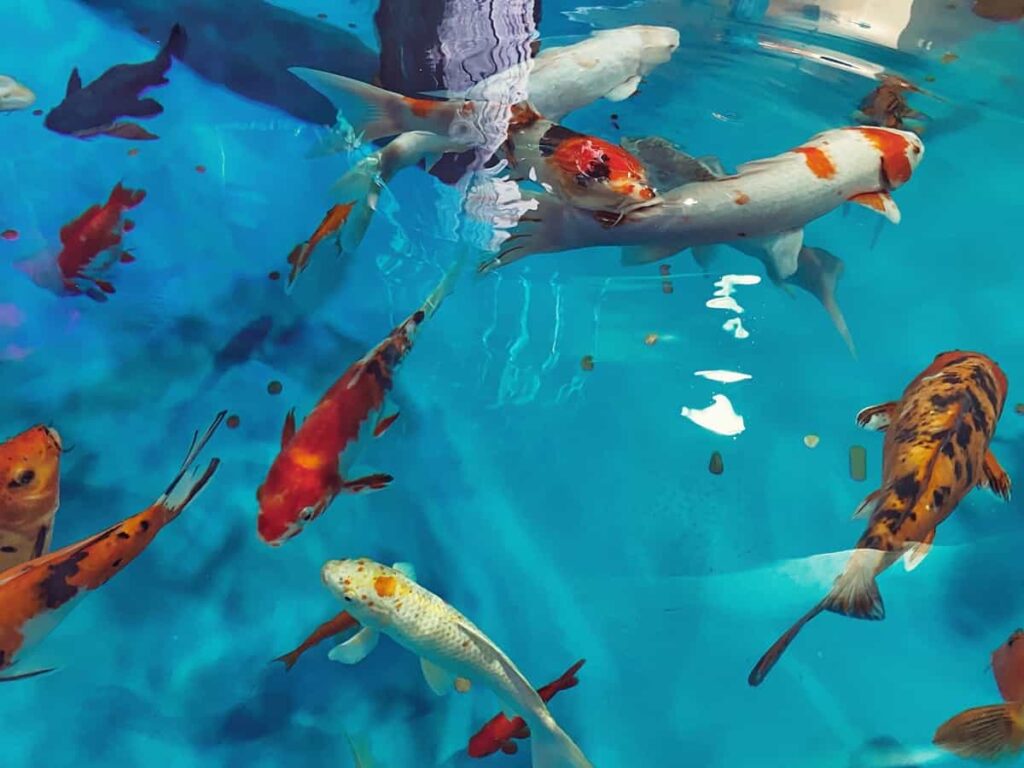
Conclusion
Transforming a swimming pool into a captivating Koi fish pond is rewarding. You can create an alluring outdoor oasis by considering vital factors like filtration, size, water quality, and fish care. With meticulous planning and professional advice, your converted pond will offer a harmonious blend of aesthetic beauty and aquatic vitality.
- How to Maximize Sheep Farming Profit
- Broccoli Varieties: Choosing the Right Cultivars for Your Farm
- How to Raise Pigs in Your Own Backyard: A Comprehensive Guide
- Budget Friendly Sheep Shed Ideas: Cheap and Low-Cost Tips
- How Much Do Cattle Farmers Make: Revenue Streams in Cattle Farming
- Management Pests and Diseases in Your Cotton Field
- Sheep Farming Business Plan for Beginners
- Aquaponic Farming at Home: A Step-By-Step Guide
- Profitable Village Farming Business Ideas in 2024
- High-Yield Aquaculture: Fast-Growing Fish for Farming
- Effective Fish Pond Construction Techniques for Beginners
- Irrigation and Water Management in Pineapple Farming
- Blossom to Harvest: Mastering Flowering and Pollination in Papaya Farming
- Pig Fattening Essentials: From Selection to Sale for Beginners
- Raising Wagyu Cattle: A Complete Guide for Premium Beef Production
- Soil Types and Their Water Holding Capacity
- Optimizing Irrigation Schedules for Coconut Groves for Enhanced Yield
- Espresso Your Garden: Coffee Grounds for Healthier Acid-Loving Plants
- The Best Soil Mix for Snake Plants: How to Mix Your Own Snake Plant Soil
- Green Thumb Success: Expert Tips for Cultivating Greenhouse Beans All Year Round
- Bloom All Year Round: The Ultimate Guide to Indoor Hyacinth Care
- Eco-Friendly Gardening: How to Make Liquid Fertilizer from Kitchen Waste
- Ultimate Guide to Grow Anise in Pots: Explore Seed Propagation to Harvesting
- Guide to Raising Chester White Pigs: Discover Breed Facts to Growth Management
- Mastering the Elegance: The Ultimate Guide to Weeping Cherry Tree Care, Planting, and Maintenance
- Ultimate Guide to Planting Garlic in Grow Bags: Growing Strategies for Beginners
- How to Fix Spider Plant Leaf-Related Problems: Natural and Organic Remedies
- 10 Reasons Why Your Tulsi Plant is Shedding Leaves: Home Remedies and Solutions
- Optimizing Growth and Yield: The Advantages of Palm Bunch Ash Fertilizer
- Utilizing Neem Oil Extract as a Natural Pesticide for Hydrangea
- From Soil to Harvest: Various Ways in Which Farmers Can Use AI Tools
- Steps to Encourage and Induce Citrus Flowers: A Comprehensive Guide
- How to Fix Snake Plant Leaf-Related Issues: Natural and Organic Remedies
- Transform Your Garden into a Fragrant Oasis with Raat Ki Rani (Night Blooming Jasmine)
- Discover the Ideal Chicken Breeds for Philippine Farms
- How to Create a Poultry Egg Farm Business Plan for Profits
